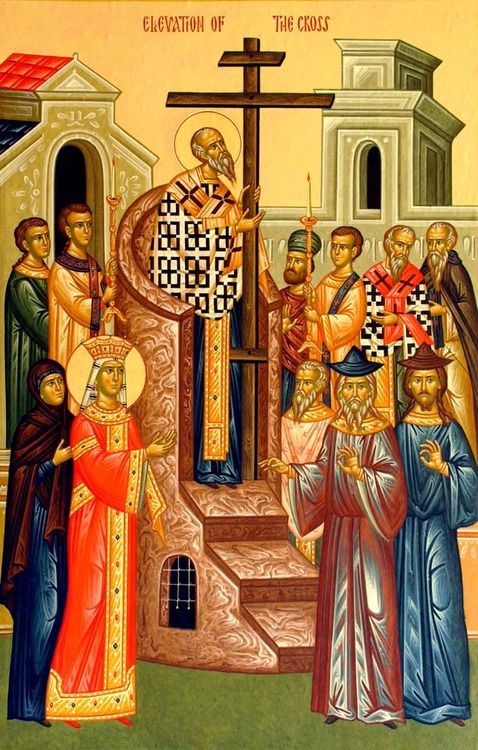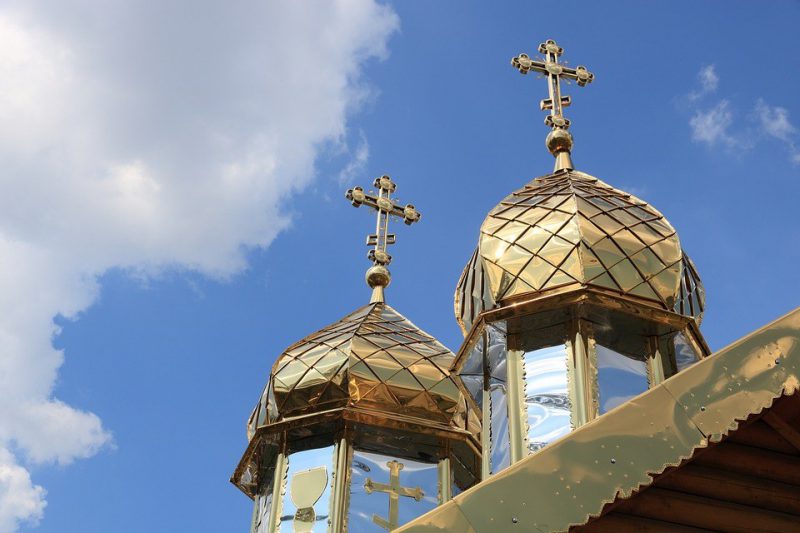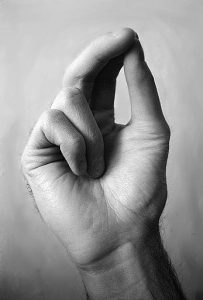When you enter an Orthodox Church, one of the first things you’ll notice is someone making the sign of the Cross. A person may do this as he venerates an icon. Alternatively, she may do so as she passes into the main area of the church, or as the priest censes the congregation. You may also notice the way the Orthodox make the sign of the cross is a bit different than you might have seen in other Christian communities. In this post, we explain the meaning of the sign of the Cross, its origins, and when, how, and why Orthodox Christians use it in worship.
Estimated reading time: 9 minutes
Table of contents
What is the sign of the Cross?
As the instrument Christ chose to bring about His ever-memorable and life-creating death, the Cross holds a special place in the heart of every Orthodox Christian. We understand that this symbol, once a primitive means of torture and capital punishment, now reminds us of Christ’s victory over death. Orthodox Christians make the sign of the Cross because it affirms what we believe about Christ as the Incarnate Son of God and all that He did for us. It is an outward manifestation that illustrates our view of God in Trinity (Father, Son, and Holy Spirit) and our belief in the two natures of Christ (fully God and fully Man). It is, in essence, a physical form of prayer.

Because of our love for the sign of the Cross, the Orthodox use it daily. Not only do we use it during worship, but also before and after meals, during personal prayer, and in moments of worry or need. The saints, and Christ Himself, make this sign in holy icons. We love the cross perhaps just as much as we love the Theotokos, if not more. Because Christ used it to bring about our salvation. To show our love and devotion to Christ, during any given service or liturgy, the faithful may cross themselves close to one-hundred times!
The origins of the sign of the Cross
The first mention of Christians making the sign of the Cross dates back to the 2nd Century. In the early Church, sources explain that the sign was only made upon the forehead and other objects, with only one finger, until at least the 4th century. Around this time, Christians then began to use two fingers to make the sign of the Cross, each finger representing one of the natures of Christ – fully God and fully Man. Historians believe they made the sign this way to guard against the heresy of Monophysitism, which rejected the Council of Chalcedon (451) and claimed that Christ had only one divine nature. We still do not know if this was a universal custom, or something confined to the region of Antioch, the location from which these primary sources came.
Read More: Quick Facts About The Seven Ecumenical Councils
Around the 9th century, the practice of using three fingers became prevalent in most of the Orthodox East and West. The exact point of origin for the three-fingered sign of the Cross remains a mystery. However, we do know it was present prior to the Great Schism (1054) because of the writings of Pope Leo IV, who reposed in 855 A.D., nearly two-hundred years before the schism between the Orthodox East and Latin West. Others including Aelfric, Abbot of Eynsham in England, and Pope Innocent III have also described the sign of the Cross in the same way as Pope Leo IV.
By the 12th century, most churches in the East (with the exception of the Russian Church, which accepted the practice in the 1600s) adopted the practice of making the sign of the Cross with three fingers. Interestingly, the Monophysites, Copts, Syrians, Armenians, and Ethiopians also adopted this practice.
How to make the sign
If you’ve ever come to an Orthodox service and looked around, you probably saw someone crossing themselves at some point. To newcomers and inquirers, this can be a bit strange, since we cross ourselves differently than other Christians. Let’s walk through the Orthodox way of making the sign of the cross, step by step.
Time needed: 1 minute
How to Make the Sign of the Cross
- Join the thumb, index, and middle fingers of your right hand.
- Rest the other two fingers of your right hand down against your palm.
After steps 1 and 2, your right hand should look like this:
- Take that hand and touch your joined fingertips to your forehead.
Let your fingers rest there for a moment.
- Then bring your fingertips down to your abdomen.
Again, let your fingers rest here a moment. Some people bring their fingers only as far as the chest, while others reach down to their navel. Either of these is acceptable.
- Move your fingertips to touch the front of your right shoulder.
- Finally, touch your fingertips to the front of your left shoulder.
If your movements match the bishop in this .gif, you did it correctly! Keep in mind the .gif is mirrored, so your arm should move in the opposite direction of the bishop’s.

Orthodox practice in making the sign of the Cross is the opposite of Roman Catholics and some Protestants, who often go from left to right. Roman Catholics also typically use all five fingers to cross themselves. This practice follows a decree set forth by Pope Pius V in 1569 A.D. Protestant practice in making the sign of the cross, much like Protestantism itself, varies. They do not expressly prohibit it. But they do not encourage it either, because there is no Biblical command to use the sign of the cross.
Variations when making the sign
You may also have noticed some Orthodox Christians make the sign three times in a row, while others only do it once. Some make large sweeping motions, while others keep things simple and small. All these variations! But, which way is the right way?
Put simply, there isn’t one. Crossing yourself is not an issue of dogma (belief necessary for salvation) in Orthodoxy. Instead, it is a matter of personal piety. In other words, aside from the arrangement of the fingers and direction of the movement, all else is up to you. If you feel moved to always make the sign of the cross in three’s, you may do so. If you wish to venerate icons in a slightly different manner than another parishioner, you can. Each Orthodox Christian can express his or her faith in whatever physical ways they feel necessary, as long as they do so out of love for God. (If you do things instead to bring attention to yourself and feed your pride, you should reflect upon that.)
Why make the sign of the cross this way?
The arrangement of the fingers while making the sign of the cross is incredibly important. Why? Because the sign is an outward manifestation of inward belief, proclaiming Truth in a demonstrable way. The three fingers joined together above the palm symbolize the Holy Trinity (Father, Son, and Holy Spirit). Meanwhile, the ring and “pinky” figure represent the two natures of Christ. These two fingers come down to touch the palm of the hand, which symbolizes Christ descending to earth.
The Orthodox follow an impulse to make everything we do reinforce and proclaim the Faith. The sign of the cross is no exception.
When to make the sign
Because crossing yourself is an issue of personal piety, the Orthodox do not have strict guidelines about when you should and should not cross yourself. In the Orthodox tradition, we cross ourselves on many occasions. Below is a list of times when you should cross yourself:
- Whenever the priest, chanter, reader, or choir invokes or alludes to the name of the Holy Trinity
- At the beginning and/or end of personal (and communal) prayer
- Upon entering and leaving the church
- When venerating holy icons, relics, the cross, or the Gospel
- Before receiving Communion*
- Whenever you pass in front of the Holy Altar, whether the doors are open or closed
During any given liturgy, we may cross ourselves more than one hundred times!
The above is by no means an exhaustive list. We cross ourselves many other times as well. Again, it all comes down to personal choice. If the Holy Spirit moves you to express your piety in a particular way, no one will judge you or look at you strangely for it.
When NOT to make the sign
Though the Orthodox make the sign of the cross rather liberally, there are a couple times when we should not make the sign during services:
- At the chalice before or after taking Holy Communion*
- Whenever a bishop or priest blesses the congregation with his hand and says, “Peace be to all.” Here, we merely give a slight bow and receive the blessing.
Conclusion
The sign of the cross means everything to the Orthodox Christian. It symbolizes a crucial event in the story of mankind’s salvation. And it allows the faithful to commune with God in a way that transcends understanding. So don’t be surprised if you see the sign of the cross being used the next time you visit an Orthodox parish! If you are not Orthodox, please don’t feel as though you must make the sign of the Cross. We make the sign out of our deep love for God, as a way of expressing with our bodies our faith in Him. You need not make the sign until you, too, feel such conviction.
*Notice we mentioned Communion in both lists? Here’s why! If you cross yourself too close to the chalice, you might hit the chalice with your hand, or cause some of the Body and Blood of Christ to spill. However, it is okay for you to cross yourself before approaching the chalice and after backing away to receive blessed bread.
Read More: Church Etiquette: The Ultimate Guide



4 Responses
Very helpful article! Thanks. Most Latins attach the Trinitarian formula, “In the name of the Father and of the Son and of the Holy Spirit,” to the sign of the Cross, but I don’t see that this is a requirement in Orthodoxy.
Mauricio,
Christ is in our midst! We are glad you found the article helpful. And you are right: Orthodoxy does not “require” the name of the Trinity be invoked by the one making the sign of the Cross. Some people choose to recite the invocation, while others simply recall the Trinity within the nous (heart) and say nothing aloud. There are many times when the Trinity is not invoked directly, but is merely alluded to, and most Orthodox Christians will cross themselves at these times as well. God bless!
Christ is in our midst! I love the article. It’s is very informative. In Ethiopean and Eritrean orthodox, we make a cross sign using two fingers. Holding together index finger vertically and middle finger horizontally making a cross sign and holding thumb, ring, and small fingers to the palm ( proclaiming Holy Trinity). Then, while making a cross sign, we start from our forehead down to the chust (proclaiming that our Lord Jesus Christ came down from heaven down to the earth), from left shoulder to the right shoulder ( proclaiming that our Lord Jesus Christ brought us from death to life), mostly three times. Please remember me in your prayers.
May God bless you abundantly!
Haile,
He is and ever shall be! It sounds as though you come from the Oriental Orthodox tradition, based on your description. Is this correct? And naturally, we will indeed pray for you! God bless!